Paddle at FMTC grows
Back to Top
Read More


Read More
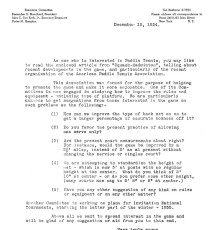
The United States Paddle Tennis Association (USPTA) had abandoned the name American Paddle Tennis Association under which it was first organized in 19261 With the permission of the USPTA, the newly formed governing body for platform tennis adopted the former name of the USPTA. Blanchard latter regretted that they did not make a clearer distinction between the two games. Source: Adapted from Fessenden S. Blanchard, Paddle Tennis, 1944 Note 1: According to an article in Paddle World in Fall 1976 the date that the Rev Beal and Frank Contessa formed the APTA was 1922 - see Frank B Contessa
Read More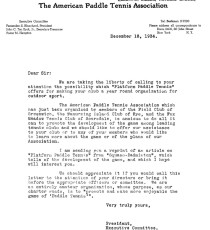
Blanchard, a co-inventor of the game along with James Cogswell, and one of the five co-founders of the American Paddle Tennis Association became the first President. Although Jack Ten Eyck Jr. had been the driver behind starting the APTA, it seemed sensible to have Blanchard take the lead, as he was a tireless promoter of the game he loved. Ten Eyck served as the APTA’s first Secretary. During his tenure on the APTA Board Blanchard also acted as Secretary (1935-1941), chief correspondent and publicist for the game. He authored two books on the game – Paddle Tennis (1944) and Platform Paddle Tennis (1959). Source: Adapted from Fessenden S. Blanchard, Paddle Tennis, 1944, and Platform Paddle Tennis, 1959
Read More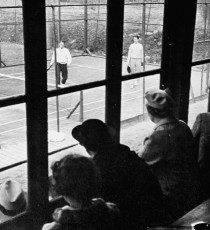
By the fall of 1934, the Great Depression had begun to hit many clubs extremely hard. Membership in the Fox Meadow Tennis Club, which had been well over 100 families, dropped to 77. The club had begun to run a deficit. Strenuous measures had to be taken. There were two schools of thought. One school favored extreme economy, saving the cash reserve as long as possible. Another group, having total faith in what platform tennis might do for the club, favored putting up another platform. They suggested raising part of the funds by members' underwriting. This would provide a stove for the clubhouse, and enable it to function fully as a winter club. To help put over this policy, they urged the establishment of a special winter membership for the six months from November 1, 1934, to May 1, 1935. Those willing to bet on the future of platform tennis won out, and the newly authorized court di[...]
Read More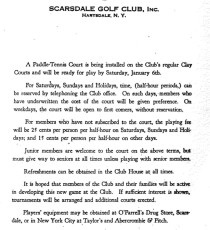
The article was in the March 1, 1935 edition and had been written by Fessenden S. Blanchard
Read More
In 1935, the American Paddle Tennis Association started conducting a series of annual championship tournaments, held during January, February and March—the height of the season. Included for the first three years were Men’s and Women’s singles championships. But interest waned and singles were dropped in 1938. Blanchard claimed early on that paddle really was just a doubles game. Source: Fessenden S. Blanchard, Paddle Tennis, 1944 For the first five years, with one exception, teams from the Fox Meadow Tennis Club of Scarsdale dominated these tournaments, occupying both the winning and runner-up positions. By 1940, there were 17 member clubs in the APTA, most of which entered teams in the men's doubles. However, the experience and a large number of quality teams from the Scarsdale contingent kept them at the top of the heap. The one exception came in 1936 when a strong te[...]
Read More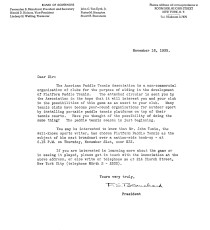
On November 18, 1935, brochures were sent out to Eastern Lawn Tennis Association member clubs and to others potentially interested in the game. These had photos and a description of platform tennis; tournament records of the previous year; a diagram of the platform with measurements; rules and regulations; and required equipment. Principal activities of the Association: (1) Annual Reports (2) Answering inquiries about the game and helping individuals or clubs to get started (3) Planning and Conduct of National Championships (4) Establishment of rules and regulations and conducting investigations regarding possible improvements to the court, equipment, rules and regulations (5) Furnishing information about tournaments and results to stimulate publicity (6) Selling official plans and specifications for courts (7) Organizing exhibition matches (8) Providing leadership, in coo[...]
Read More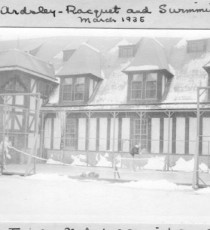
The Ardsley Country Club in Ardsley-on-Hudson, NY was one of the first clubs to build a court based on the APTA's grow the game initiative. Blanchard's Scrapbook included a picture of the court being used in 1935 although the caption was Ardsley Racquet and Swim Club which had by then merged with the Ardsley Club2, an informal offshoot of The Ardsley Casino1, that year to form The Ardsley Country Club. Interestingly the player in the dark sweater is very likely Stuart R. Stevenson3, an avid racquets player, who was the club's representative to the APTA. He was the grandson of one of the founder of the The Ardsley Casino in 1985, Amzi Lorenzo Barber "The Asphalt King", and his wife Julia. The courtIt was removed during WWII as the wood was rotting and could not be replaced due to lack of materials during the war. Note 1: The Ardsley Casino was created through the support of some of[...]
Read More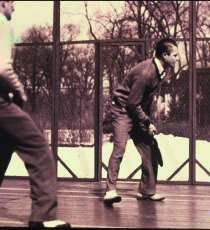
Fox Meadow Tennis Club member and former FMTC President (1936) Henry B Eaton, designed a collapsible platform that could be laid on an existing tennis court during the off-tennis season without damaging it. Eaton talked the New York lumber company company he worked for and the the forerunner of the Gates Sports Platform Company, to make the Eaton portable platform. The court was easy to transport and set up and only cost about $500, which made it affordable even during the Depression. These easy to install and cheap platforms were invaluable in growing the game. Source: Adapted from Fessenden S. Blanchard, Platform Paddle Tennis, 1959 Historical Factoid: Eaton's wife, Jean Eaton, was the winner of the Women's Doubles and Singles Nationals in 1935 (the inaugural tournaments) and the Women's Doubles in 1936.
Read More